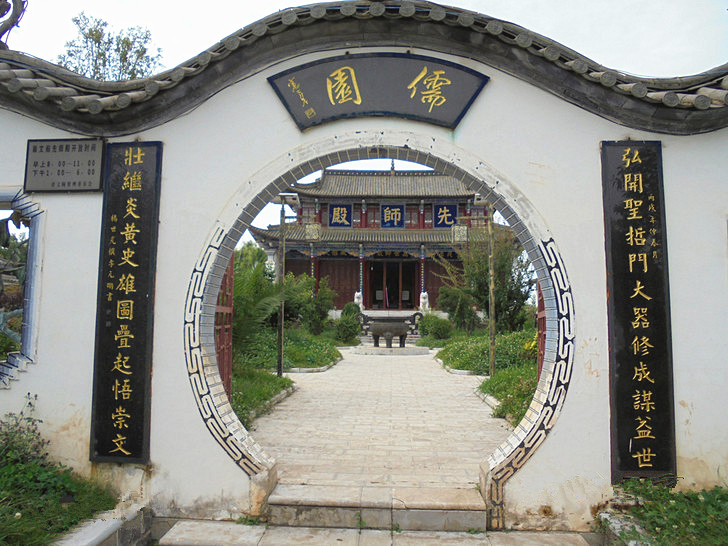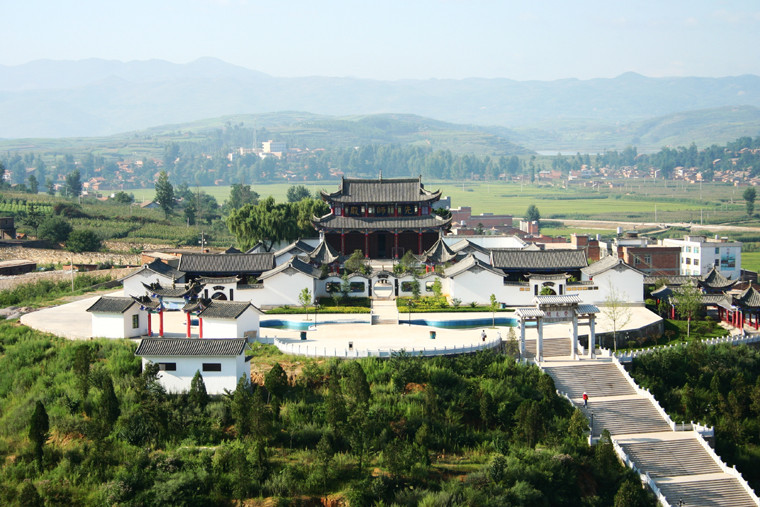Chongwen Pavillion in Ludian County, Zhaotong
Chinese Name: 鲁甸县崇文阁
English Name: Chongwen Pavillion in Ludian County, Zhaotong
Chongwen Pavilion is a prominent cultural and historical landmark located in the new urban area of Ludian County. Covering a land area of 9 acres with a building space of 1,167.5 square meters, the pavilion features a variety of structures, including a main hall dedicated to Confucius, exhibition rooms, recreational rooms, and offices for the local literary federation, totaling 11 rooms. The site also includes traditional Chinese architectural elements such as long corridors, archways, a garden, a pond, and small bridges, creating an elegant and dignified atmosphere.
Cultural and Historical Significance
- Historical Roots: The original Chongwen Pavilion was established in 1777 during the 42nd year of Emperor Qianlong’s reign, highlighting Ludian’s long-standing tradition of valuing education and culture. The pavilion was initially located at the base of what is now called Wenping Mountain, giving the county the historical name “Chongwen Town.” Though the original structure was eventually destroyed, five ancient cedar trees still stand as reminders of its legacy.
- Purpose and Cultural Role: Chongwen Pavilion serves as a sacred place dedicated to venerating Confucian sages, similar to the Confucian Temple in Qufu, Shandong. It stands as a symbol of traditional Chinese Confucian values, emphasizing the importance of education, cultural refinement, and moral integrity.
Reconstruction and Development
- Reconstruction Efforts: The modern reconstruction of Chongwen Pavilion began in June 2005, expanding the site to over 20 acres. The complex now includes multiple architectural elements such as Chongwen stone steps, Chongwen archway, Pan Pool, Zhuangyuan Bridge, Ruyuan, First Teacher Hall, Zhonghe Hall, Xuewen Hall, Minglun Hall, Ink Wash Studio, Scholar’s Pavilion, Honoring Teacher Archway, and a viewing platform.
- Symbolic Location: Situated on Wolong Mountain’s dragon-head-shaped peak, Chongwen Pavilion symbolizes a strategic priority of education in the region, as its elevation is even higher than that of the government office building.

Architectural and Scenic Features
- Key Architectural Elements:
- Chongwen Stone Steps and Archway: Leading up to the pavilion, these features emphasize the importance of knowledge and cultural heritage.
- Pan Pool and Zhuangyuan Bridge: A lotus-shaped pool symbolizes the continuous pursuit of knowledge, with the Zhuangyuan Bridge historically crossed by scholars before taking their exams.
- Gardens and Pavilions: The pavilion complex includes three main courtyards, with the central courtyard named Ruyuan. The design features decorative walls with plum, orchid, and bamboo motifs, evoking a sense of serenity. The central area also houses the First Teacher Hall and additional side chambers.
- Scholar’s Pavilion and Ink Wash Studio: Located on either side of Ruyuan, these structures each have a main hall and side chambers, reflecting traditional Chinese architecture and serving as spaces for contemplation and cultural activities.
- Nine-Bend Corridor and Viewing Platform: The corridor leads to a viewing platform, offering panoramic views of Ludian County, including both old and new districts, Century Avenue, and various urban landmarks, blending ancient charm with modern development.

Significance and Community Impact
Chongwen Pavilion is more than just a historical site; it is a symbol of cultural pride and educational importance in Ludian County. By embodying traditional Confucian values, the pavilion encourages unity, cultural appreciation, and a commitment to education among all ethnic groups in the area. It serves as an inspiring reminder of the rich heritage and bright future of Ludian County, fostering a love for the homeland and a desire to build a prosperous and harmonious community.

 7 Days GolfingTour
7 Days GolfingTour
 8 Days Group Tour
8 Days Group Tour
 8 Days Yunnan Tour
8 Days Yunnan Tour
 7 Days Shangri La Hiking
7 Days Shangri La Hiking
 11 Days Yunnan Tour
11 Days Yunnan Tour
 6 Days Yuanyang Terraces
6 Days Yuanyang Terraces
 11 Days Yunnan Tour
11 Days Yunnan Tour
 8 Days South Yunnan
8 Days South Yunnan
 7 Days Tea Tour
7 Days Tea Tour
 8 Days Muslim Tour
8 Days Muslim Tour
 12 Days Self-Driving
12 Days Self-Driving
 4 Days Haba Climbing
4 Days Haba Climbing
 Tiger Leaping Gorge
Tiger Leaping Gorge
 Stone Forest
Stone Forest
 Yunnan-Tibet
Yunnan-Tibet
 Hani Rice Terraces
Hani Rice Terraces
 Kunming
Kunming
 Lijiang
Lijiang
 Shangri-la
Shangri-la
 Dali
Dali
 XishuangBanna
XishuangBanna
 Honghe
Honghe
 Kunming
Kunming
 Lijiang
Lijiang
 Shangri-la
Shangri-la
 Yuanyang Rice Terraces
Yuanyang Rice Terraces
 Nujiang
Nujiang
 XishuangBanna
XishuangBanna
 Spring City Golf
Spring City Golf
 Snow Mountain Golf
Snow Mountain Golf
 Stone Mountain Golf
Stone Mountain Golf















